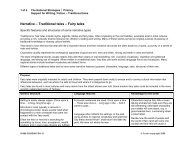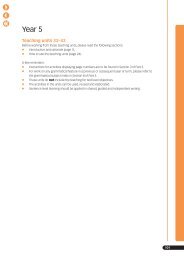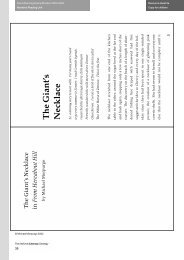You also want an ePaper? Increase the reach of your titles
YUMPU automatically turns print PDFs into web optimized ePapers that Google loves.
PLANNING PROGRESSION in writing report text<br />
Year 2 Term 3 T21<br />
Objective: Write non-chronological reports based on structure of known texts,<br />
using appropriate language to present, sequence, categorise ideas.<br />
Example<br />
Shared writing: A page for a class book.<br />
Individual/guided work: Pupils write own page of same book using<br />
formatted page or writing frame.<br />
Year 3 Term 1 T22<br />
Objective: Write simple non-chronological reports fro m known<br />
information for known audience, using notes made to organise and<br />
present ideas.<br />
Example<br />
Shared writing: Teacher models how to make brief notes on a<br />
skeleton to organise ideas. Shared writing of a page for a class book<br />
based on notes.<br />
Individual/guided work: Pupils write own notes on similar skeleton<br />
framework, then write own page for same book based on<br />
teacher’s model.<br />
Year 4 Term 1 T27<br />
Objective: Write non-chronological reports using organisational<br />
devices (e.g. numbered lists, headings), generalizing details,<br />
deleting unimportant detail.<br />
Example<br />
Shared work: Teacher demonstrates how to plan a poster,<br />
based on known subject matter, showing how to (1) brainstorm<br />
for information; (2) select and categorise facts. Shared writing of skeleton notes and poster.<br />
Individual/guided work: Pupils plan and write own posters, using the same technique.<br />
department for<br />
education and skills<br />
National Curriculum and NLS Objectives<br />
The NLS objectives link with and support work in the<br />
rest of the curriculum in several ways. We can:<br />
� Bring content knowledge and reading/writing<br />
activities from the curriculum into the Literacy<br />
Hour. Work in the Literacy Hour is then linked to<br />
real purposes for reading, writing, speaking and<br />
listening.<br />
� Teach language and literacy in both the Literacy<br />
Hour and other subjects, weaving the work in<br />
subjects and the Literacy Hour explicitly together.<br />
� Apply and practise the skills learned in the<br />
literacy our in new contexts in the rest of the<br />
curriculum.<br />
� Use language work done in other subjects to<br />
access children’s English abilities.<br />
Linking QCA Units of Work and NLS <strong>Writing</strong><br />
Objectives<br />
In order to help with planning, links have been<br />
mapped between NLS objectives and existing writing<br />
activities within QCA schemes of work for history,<br />
geography, science, religious education and design<br />
and technology.<br />
Visit the QCA website:<br />
� www.qca.org.uk/ca/subjects/english/literacy<br />
Year 5 Term 2 T22, 23<br />
Objective: Plan, compose, edit and refine short non-chronological reports, using reading as a source, focusing on<br />
clarity, conciseness, impersonal style and recording sources used.<br />
Example<br />
Shared work: Teacher demonstrates how to research and plan a page for a reference book on one aspect of a class<br />
topic. Shared note-making and writing of the page.<br />
Individual/guided work: Pupils research, plan and write their own pages for the reference book.<br />
Year 6 Term 1 T17<br />
Objective: Write non-chronological reports linked to other subjects.<br />
Example<br />
Shared work: Shared research, planning and writing parts of an information leaflet on a subject which will<br />
provide a model for pupils’ individual work.<br />
Individual/guided work: Pupils research, plan and write own information leaflets, linked to work in another<br />
curricular area.<br />
Year 6 Term 3 T22<br />
Objective: Select appropriate style and form to suit a specific purpose and audience, drawing on knowledge<br />
of different non-fiction text types.<br />
Example<br />
Shared work: Teacher (1) models how to select appropriate non-fiction text type for a piece of writing; (2)<br />
revises how to plan and write that text type, depending upon purpose and audience.<br />
Individual/guided work: Pupils, given audience and purpose, select style and form for a range of pieces<br />
of writing, and plan and write one piece.<br />
With thanks to staff and children of Hyde Park Junior School, Plymouth.








